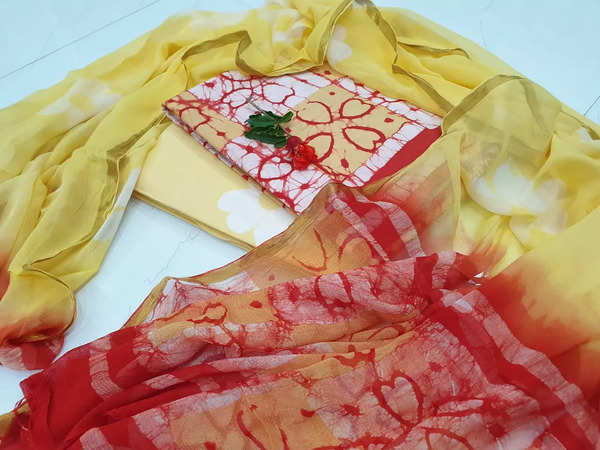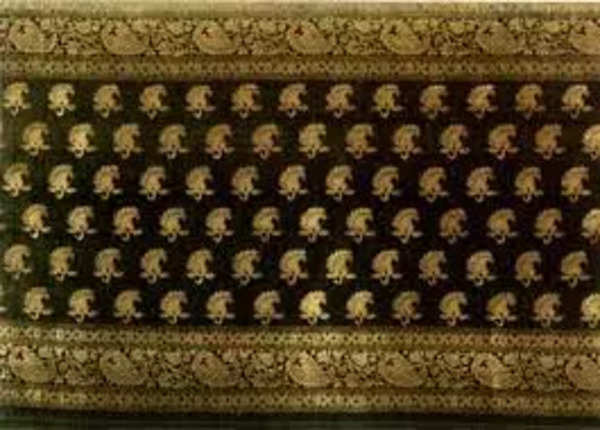Zari: An untold story – Times of India
Historical roots
The origins of Zari work can be traced back to the Mughal era in India, around the 16th century.Influenced by Persian craftsmanship, Zari found its way into the royal courts, adorning garments worn by kings, queens, and nobility. The word ‘Zari’ itself is derived from the Persian word ‘Zar,’ meaning gold. Initially, pure gold and silver threads were used, signifying wealth and prestige.

Materials and techniques
Zari work involves the use of metallic threads, which can vary in composition. Traditionally, genuine gold and silver were employed, but due to cost and availability, modern Zari often incorporates materials like copper or metallic alloys. These threads are meticulously woven into the fabric using a variety of techniques, the most common being the couching method.
In the couching technique, the metallic threads are laid flat on the fabric, and a contrasting thread is used to secure them by stitching over the top. This method allows for intricate designs and patterns to be created, ranging from delicate floral motifs to elaborate geometric shapes.
Regional variations
Zari work has evolved differently in various regions, each contributing its unique flair to this ancient art form.
Benarasi Zari: Benaras, or Varanasi, is renowned for its opulent silk sarees adorned with intricate Zari work. The gold and silver threads are woven into the silk, creating elaborate patterns that often include floral and foliate designs. Benarasi saris are highly prized for their craftsmanship and are considered a symbol of luxury.
Pakistani cricketer -Imam-ul-Haq -ties the knot -with -Anmol Mehmood
Kutchi Zari: Hailing from the Kutch region of Gujarat, Kutchi Zari work is characterized by vibrant colours and bold designs. The craft often features mirror work along with Zari, creating a dazzling effect. Kutchi embroidery, including Zari work, is traditionally found on garments like cholis (blouses) and dupattas.
Zardozi: Zardozi, a form of Zari work, is prevalent in Lucknow and is distinguished by the use of metallic threads along with embellishments like sequins, beads, and pearls. This style is often employed on fabrics like velvet and silk, creating a luxurious texture and appearance.
Significance in Indian culture
Zari work is deeply embedded in the cultural fabric of India, symbolizing more than just artistic expression. It is a reflection of heritage, a connection to the country’s regal past, and a celebration of craftsmanship passed down through generations. Bridal attire, ceremonial garments, and religious textiles often feature elaborate Zari work, adding a touch of splendor to auspicious occasions.
Evolution in contemporary fashion
While Zari work has a strong historical foundation, it has gracefully adapted to contemporary fashion trends. Designers globally incorporate Zari elements into their collections, blending traditional craftsmanship with modern aesthetics. The versatility of Zari allows it to be featured on a range of garments, from saris and lehengas to dresses and accessories.

Challenges and conservation
Despite its enduring appeal, Zari work faces challenges in the modern era. The high cost of genuine gold and silver threads, coupled with the labor-intensive nature of the craft, poses economic hurdles. Additionally, the rise of machine embroidery has threatened the survival of handcrafted Zari work.
Efforts are underway to preserve and promote this traditional art form. Artisans, recognizing the cultural importance of Zari work, are incorporating sustainable practices and experimenting with contemporary designs to attract new audiences. NGOs and government initiatives are also playing a role in providing support and education to artisans, ensuring the continuity of this precious heritage.
function loadSurvicateJs(allowedSurvicateSections = []){ const section = window.location.pathname.split('/')[1] const isHomePageAllowed = window.location.pathname === '/' && allowedSurvicateSections.includes('homepage')
if(allowedSurvicateSections.includes(section) || isHomePageAllowed){ (function(w) { var s = document.createElement('script'); s.src="https://survey.survicate.com/workspaces/0be6ae9845d14a7c8ff08a7a00bd9b21/web_surveys.js"; s.async = true; var e = document.getElementsByTagName('script')[0]; e.parentNode.insertBefore(s, e); })(window); }
}
window.TimesApps = window.TimesApps || {}; var TimesApps = window.TimesApps; TimesApps.toiPlusEvents = function(config) { var isConfigAvailable = "toiplus_site_settings" in f && "isFBCampaignActive" in f.toiplus_site_settings && "isGoogleCampaignActive" in f.toiplus_site_settings; var isPrimeUser = window.isPrime; if (isConfigAvailable && !isPrimeUser) { loadGtagEvents(f.toiplus_site_settings.isGoogleCampaignActive); loadFBEvents(f.toiplus_site_settings.isFBCampaignActive); loadSurvicateJs(f.toiplus_site_settings.allowedSurvicateSections); } else { var JarvisUrl="https://jarvis.indiatimes.com/v1/feeds/toi_plus/site_settings/643526e21443833f0c454615?db_env=published"; window.getFromClient(JarvisUrl, function(config){ if (config) { loadGtagEvents(config?.isGoogleCampaignActive); loadFBEvents(config?.isFBCampaignActive); loadSurvicateJs(config?.allowedSurvicateSections); } }) } }; })( window, document, 'script', );
For all the latest lifestyle News Click Here

